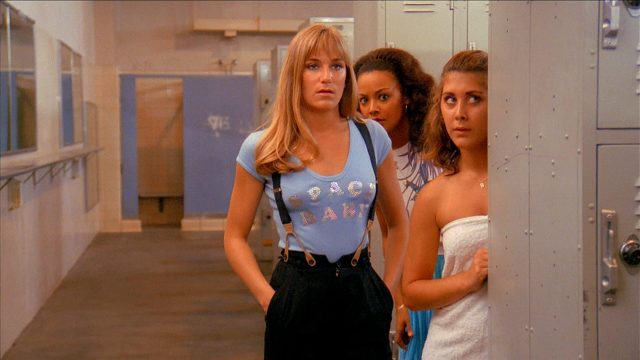The Slumber Party Massacre is an odd little entry in the slasher film canon, existing as the weird and badly brought-up love child of Black Christmas and Sleepaway Camp. It has an unusual history: the script was written by Rita Mae Wilson, of Rubyfruit Jungle fame, who intended it to be a kind of spoof on slasher conventions. While it was eventually shot as a straightforward example of the genre it was meant to satirize, it has an unusual bubbliness and an even more unusual depth of interest in the young women who form its cast. If Wilson’s intentions were lost in production, something of her spirit was at least preserved by director Amy Holden Jones.
(Sunil Patel did a terrific job covering the film’s various horror and comedic merits last year for Year of the Month, so I’ll take a different tack here.)
In a genre stuffed to the gills with disposable victims, The Slumber Party Massacre takes the time to at least sketch out efficient, memorable characterizations for its girls; instead of the usual structure of either a single final girl or a final girl and her stalwart-but-doomed male love interest, the film centers on two girls who might be friends if the bullshit structure of high school didn’t get in the way. There’s actual texture to the relationships–not the high school romances, really, but the various friendships and enmities and family ties. And an early victim, whose death is meant to establish fear of the killer, is allowed to show unexpected competence and courage, enough to make her and her actions stand out.
Even the obligatory and numerous cheesecake shots are largely done with a remarkably low level of sleaze, at least by my standards. (The notable exception is a severe close-up of a grope, shot in such a way that this isn’t about sex or nudity or even the whole body but rather TIT!!!–it’s about as erotic as a diagram of a breast exam, which is to say it still worked for somebody.)
Of course, all of this is still surrounded by people being killed with a power drill; with a few exceptions, the horror is mostly too by-the-numbers to land. The acting is mostly either weak or unremarkable. But the film nonetheless makes for interesting viewing, especially as an example of the way underrepresented perspectives–here, a female director and a queer female screenwriter–can provide different and welcome takes on pulp and schlock. Low art needs its diversity too, and The Slumber Party Massacre isn’t a bad argument for the appeal of it.
The Slumber Party Massacre is available for free with Amazon Prime.

